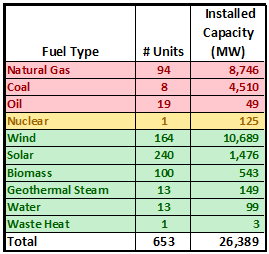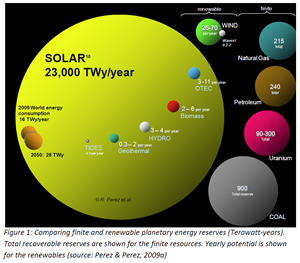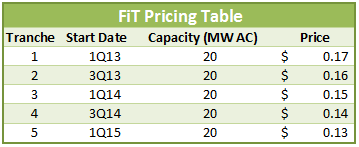Welcome to the
Run on Sun Monthly Newsletter

In this Issue: |
January, 2013
Volume: 4 Issue: 1
Who Pays for Solar Power?We wrote before about an upcoming study from the California Public Utilities Commission (CPUC) to determine the overall cost-benefit of installing solar. Well in advance of that study, the investor-owned utilities (IOUs) in California are coming out swinging, with populist rhetoric about solar's unfair impact. But just because a utility says something, doesn't make it true! Here's our assessment. In the closing weeks of 2012 several news stories appeared, making the case for the IOU's POV regarding solar. (This one from the San Francisco Chronicle is typical: Solar Power Adds to Nonusers' Costs.) It is certainly true that solar customers pay less for distribution and transmission systems because those costs are tied to a customer's total usage and is not simply part of the fixed "customer charge" that all residential utility customers pay - including solar customers. But solar customers did not decide the nature of the utility's rate structure, and presumably the IOUs were happy to charge more to cover "fixed costs" based on usage. If that is the case, then it is equally fair to receive less from a customer with a lower monthly usage. Moreover, the "analysis" being advanced by the IOUs ignores the benefit of that net energy being provided by solar customers - since that energy largely peaks alongside the utility's peak demand, it offsets peak production energy costs for the utility. Such "peaker" plants provide the most expensive energy a utility produces, so reducing that demand is actually a significant benefit to the utility. At least one countervailing analysis asserts that solar customers are providing a net benefit: Solar Power Generation in the US: Too expensive, or a bargain? That study looked at all components of solar system benefits - including impacts on transmission and distribution - and concluded that solar power customers are actually subsidizing other users, even with solar deployment as high as 30% (the current net metering cap is just 5% and California is still a long way from reaching that goal). Make no mistake, the IOUs are coming after net metering because it is beginning to affect their bottom line - and they can predict that as costs for solar continue to fall, that enormous potential for solar energy will hurt their business model. The solar industry is in for a fight - and it will be a fight of existential proportions. |
“IOUs are coming after net metering because it is beginning to affect their bottom line…”
Help Us Spread the News!






LADWP Board Approves 100MW FiTEditor's Note: A last minute move to delay the program in the LA City Council was defeated. The FiT Program is now set to officially open on February 1, 2013. On January 11, 2013, The LADWP's Board of Commissioners unanimously approved a 100 MW Feed-in Tariff program (FiT) to begin this quarter. The program will initially pay 17¢/kWh for twenty years on projects ranging in size from 30 kW to 3 MW. We attended and spoke at the two-hour hearing; here is our report. Background
The Demonstration ProgramAnxious that it could not reliably pick a defensible price point that would thread the needle of getting subscribers without gouging rate payers, DWP set up a 10 MW demo program last spring. However, since DWP was using it for price discovery, each proposed project had to set its own price and then DWP picked the successful bids based on lowest cost. Or at least that was the plan. Unfortunately, the program was far from fully subscribed: only 26 projects were initially proposed accounting for only 7.2 MW of the intended 10. Out of those 26, only 17 passed DWP's screeners (worth just 4.6 MW) and as of today, 14 projects (from the original 26) are awaiting contract signing (despite the published "deadline" for contract execution by the end of November), amounting to only 3.7 MW at an average price of 17.5¢/kWh. So... the demo program "discovered" that at 17.5¢/kWh it could only successfully subscribe 37% of the desired target - but the 100 MW program is going to start below that price and it hopes to be successful? Yet the primary point of discussion during the hearing was whether that starting price was too high. So much for learning from the demo program. Unfortunately, that is all the public has been allowed to learn from the demo program as none of the data collected from the various bidders - including the bidders who were rejected at the outset - has been made public. It would be very helpful for FiT program participants to see what caused these other projects to be rejected so that we could avoid repeating those mistakes. It remains to be seen whether that information ever sees the light of day. ProposalThe proposal from Staff is simple enough: DWP will allocate a total of 100 MW of capacity in five, 20 MW tranches, the first of which is to be initiated sometime this quarter with the remaining four to follow every six months thereafter. The goal of staging the program in tranches was to control the administrative burden on DWP staff (which is hiring 30 more people, mostly in the interconnection area, to allow them to operate this program). Given the well-publicized problems that DWP has had with backlogs on its solar program in the past, the staged approach probably makes sense. The first tranche (originally scheduled for January 1st) is now set to roll out February 1, with the following four tranches to follow in six month increments as shown below:
The original proposal as documented called for splitting the first tranche with only the first 10 MW being allocated at 17¢/kWh. However, during the hearing, Staff urged making it uniform and the Board amended the proposal to allocate the program as shown above. (More on this below.) The price in the table above is actually what is known as the "Base Price for Energy" (BPE) because the actual price paid is subject to these Time-of-Delivery modifiers: As a result, to determine the amount that will be actually paid, the developer must perform a month-by-month, hourly-output analysis of the energy to be produced by the proposed system. (Indeed, such an output analysis is a required part of the application process.) Our analysis suggests that the ToD multipliers increase the overall price paid by anywhere from 5.5% to as much as 9.8%, depending on the azimuth of the installed system. (While not all sites are amenable to such modifications, system orientation can play a significant role in the profitability of the site and the designer would be well rewarded for doing sufficient analysis to determine the optimal azimuth and pitch given existing site constraints.) While projects from 30 kW to 3 MW are allowed under the program, each tranche is scheduled to have 20% (4 MW) set aside for small projects (30 -150 kW), meaning that such projects have a much greater chance of being included in any one tranche. In addition, small projects pay half of the fees charged to projects over 150 kW. (Thereby creating two "sweet spots" - one right at 150 kW and the other at the maximum system size of 3 MW.) Only one project can be sited per Assessor's parcel ID and all must be in territory served by LADWP. (Significantly, the project Applicant does not need to be an LA resident so out-of-town or even out-of-state landlords could convert under utilized land into a twenty-year revenue stream.) Projects need to go live within 18 months of signing their contract with LADWP, with a possible extension of another six months. Eligible projects must not have received rebates or incentives under any other LADWP program and are expressly not allowed to participate in net metering. Public CommentsA number of people spoke on the proposal, all but one supporting the program. Run on Sun was chosen to speak first, and we voiced support for the program while urging Staff to clear up a number of ambiguities, release the demo program data and make clear what would happen with the commercial net-metering program. Most importantly, we learned that DWP is planning to fund the commercial net-metering program in July with roughly $10 million at a rebate rate to be disclosed "soon". We anticipate that the commercial net-metering program will sell out immediately as of July 1, and that non-profit organizations should really focus on using that program (assuming that they receive a rebate premium as they have in the past). Other speakers - from groups like the Sierra Club and the CLEAN LA Coalition - supported the program and praised DWP Staff while encouraging additional flexibility in the program. The sole opponent was a ratepayer who complained that the cost was too high. Ratepayer Advocate CommentsIn that, the speaker's comments were echoed by Fred Pickel, Ph.D., Office of the Ratepayer Advocate. Dr. Pickel, who earns a salary of $237,000/year in his City post, complained that the BPE of 17¢/kWh was simply too high, citing unnamed "developers" who had come to him and told him that they could profitably build solar projects in the City for 11 to 12¢/kWh. Dr. Pickel declined an invitation to name those developers but he did indicate that they were associated with projects in the 30 MW scale. (He did not identify any of those projects; nor was it clear, though unlikely, whether any of them were built in the City of Los Angeles.) As a result of the unduly high BPE being offered, he claimed, LA ratepayers were being saddled with an additional $100 million over the lifetime of the FiT program. Fortunately, the Board did not rely on Dr. Pickel's "analysis" and turned instead to DWP General Manager, Ron Nichols to "put things in perspective." Nichols was nothing short of terrific, speaking with passion about the need for the FiT Program and pointing out that a program offered at 11-12¢/kWh would simply fail to be subscribed and DWP would fail to meet its Renewable Portfolio Standards (RPS) obligations. Moreover, the actual cost to ratepayers in the City was negligible - amounting to just 15¢/month for the average residential customer - a cost so low as to be exceeded by the cost of postage for mailing the payment. Moreover, by moving this program forward, residents of LA would finally "see what they are paying for" as solar installations blossomed throughout the City. It was a great response and it clearly moved the Board. Board DiscussionThroughout the hearing it was clear that the Board was concerned about the cost of the program, and the comments of the Ratepayer Advocate would have given them plenty of cover to reduce the BPE to a level that would have guaranteed the failure of the program. It was also clear that having spent this much time developing the program, both the Staff and the Board wanted to move forward with a program that would not only succeed, but send a message that the City of Los Angeles was serious about its Feed-in Tariff program. As a result, the Board rejected (politely but firmly) the importunings of Dr. Pickel. More than that, they adopted the Staff suggestion that the entire first tranche of 20 MW be offered at 17¢/kWh (on a motion by Commissioner Parfrey and subject to a "friendly amendment" from Commissioner Moss requiring Staff to report on the program 30 days prior to the release of each tranche). The ultimate vote was unanimous. Lessons LearnedIt was a long and difficult process to bring this program into being. We at Run on Sun participated in five meetings over the past two years; others, like the indefatigable Michelle Garakian of the CLEAN LA Coalition, participated in many more. Thanks to their hard work, and that of DWP Staff, this program is about to finally see the light of day. But will it succeed? We predict a cautious yes. After all, this is still LA - the most difficult local jurisdiction in which to do solar and nothing in the FiT will make that easier. (Indeed, if anything, there are now substantially more hurdles to surmount than with a net-metered system.) One thing is clear - the over-arching policy mandate of the Renewable Portfolio Standard made a difference in getting this done as it gave the Board the cover that they needed to reject the Ratepayer Advocate's call for a meaningless program, and allowed them to insist - correctly in our view - that the proposed pricing regime was necessary to meet their mandated RPS targets.
|
Half Way There:
|

|
The latest Energy Infrastructure Update issued by the Office of Energy Projects within the Federal Energy Regulatory Commission (FERC) tells the tale: lead by wind power, renewable energy sources accounted for 49.1% of 2012's new installed capacity, up from 39.9% in 2011! Thanks to the restoration of federal tax incentives for wind generation, it seems likely that both wind and solar will continue their substantial growth - wind increased by 56% in 2012 over 2011 and solar increased by 30% - into 2013. |
And these are only counting projects that make it onto FERC's radar - which means that thousands of residential and commercial-scale solar projects that were installed last year are NOT included in this chart!
To be sure, installed capacity alone is not a very good measure of the value of a generation resource onto the grid, and effective storage is going to be key to helping renewables finally silence their critics.
But these numbers are real, the jobs are real, the energy is real, and renewables are here to stay!



